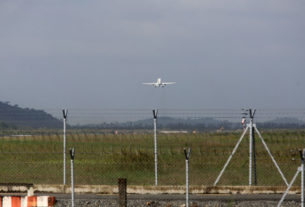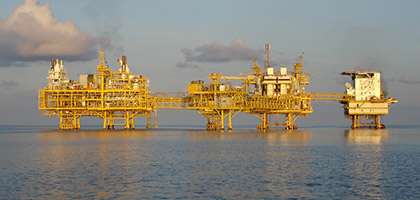Honeywell International Inc. is poised to overtake 3M Co. as the world’s biggest maker of protective gear, buoyed by $3 billion in acquisitions since 2008 and stronger workplace-safety rules in developing countries.
Annual personal safety-products revenue at Honeywell may rise past $2 billion in 2012 once it closes on last month’s $338 million purchase of Singapore-based shoemaker King’s Safetywear Ltd. 3M posted safety sales of $1.85 billion in 2010 and projects growth of more than 10 percent this year.
The companies are vying for sales in a market that may already be $20 billion worldwide. Demand for equipment such as protective glasses and fall-protection harnesses is growing twice as fast as the global economy as regulators worldwide seek to cut a toll of 321,000 on-the-job fatalities a year, said Bill Hayes, Honeywell’s president of safety products.
“The regulations are moving so fast and advancing so quickly,” Hayes said in an interview. In Asian factories where employees once wore traditional street attire, “it’s literally moving from slippers to protective footwear.”
Buying King’s Safetywear adds to three years of similar investments by Honeywell, starting with the $1.2 billion acquisition of Norcross Safety Products. That put Honeywell into competition with a variety of small manufacturers and one global company: 3M, which entered the field 40 years ago by inventing the disposable safety mask. Honeywell will discuss next year’s outlook for businesses including safety products in a webcast at 9 a.m. New York time today.
Profitable Market
“This is a highly attractive market space that I think was probably overlooked for a number of years,” said Steve Winoker, a Sanford C. Bernstein & Co. analyst in New York who recommends buying 3M and holding Honeywell. “You have good strong growth globally in a profitable area that’s highly regulated.”
3M, which made its last major safety-related acquisition in 2007, has boosted development spending on protective equipment to help drive sales growth of about 72 percent in the past five years. Newly introduced products made up 19 percent of sales in 2010, compared with 6 percent in 2005.
“We tend to emphasize that a little bit more, but we’re not adverse to going out and getting what we need,” Frank Little, chief of 3M’s Occupational Health & Environmental Safety Division, said in a telephone interview.
Honeywell Outpacing 3M
3M’s bid of $825 million earlier this year for Capital Safety Ltd., a Milton Keynes, England-based maker of safety harnesses, was rejected as too low, people familiar with the sale process said last month. KKR & Co., a New York-based private equity firm, is set to acquire the company with a bid that may value it at about $1.1 billion, the people said.
Honeywell fell 3 percent this year before today, compared with a 9 percent drop for St. Paul, Minnesota-based 3M. Honeywell slid 1.5 percent to $51.55 yesterday in New York, while 3M declined 1.1 percent to $78.51.
Honeywell and 3M compete for sales of hard hats, safety glasses, ear protection, respirators, welding helmets and other personal protection gear. 3M’s safety business includes gas- detection equipment that Morris Township, New Jersey-based Honeywell doesn’t count in its safety-sales data.
Potential markets exist in Africa, low-income countries in the Americas, the Eastern Mediterranean and Southeast Asia –the regions identified in an International Labor Organization report as having the most workplace deaths.
‘Limited Legal Framework’
3M and Honeywell benefit from efforts such as an ILO initiative for less-developed countries to form regulators like the U.S. Occupational Safety and Health Administration, said Seiji Machida, who runs a safety program for the ILO, a United Nations agency.
“Many countries still have a very primitive or limited legal framework and a bit older kind of approach to safety and health,” Machida said in a telephone interview from Geneva. “There are more countries ratifying the international agreement. It’s a good trend.”
Thailand agreed to form an independent labor safety agency in November 2010, and Singapore expanded its safety regulations to all employees, including office workers, in September.
Known for making aircraft controls and home thermostats, Honeywell has invested more in safety than any other unit since Dave Cote became chief executive officer in 2002.
Acquisitions
The company’s Life Safety unit, which includes protection gear as well as fire and gas detection systems, may account for almost 10 percent of an estimated $36.7 billion of sales this year, Honeywell said.
Personal safety products made up 56 percent of $3.3 billion in revenue for 3M’s Safety, Security and Protection Services unit last year.
That division, the fifth-largest by sales among 3M’s six businesses, accounted for 12 percent of the company’s sales in 2010. Revenue at the division may climb to as much as $4.1 billion in 2012 from an estimated $3.8 billion this year, 3M said in a Dec. 6 presentation.
“It’s a mature business and it throws off steady cash because there’s little capital intensity involved in it,” said Joel Levington, managing director of corporate credit at Brookfield Investment Management Inc. in New York, which holds 3M debt. “It’s less cyclical with decent growth.”
Disasters such as Japan’s earthquake and nuclear meltdown in March and the swine-flu scare also can spur sales. Profit margins in the protective-gear industry are more than 17 percent and new technologies that 3M and Honeywell have applied to the market are making it more difficult for smaller companies to compete, Bernstein’s Winoker said.
Both companies will probably continue adding market share by buying competitors, Winoker said.
Honeywell sees “tremendous opportunities globally to continue to roll up businesses for geographical coverage and technical extension,” said Mark Levy, chief of the company’s Life Safety unit. “There are many, many great candidates.”

